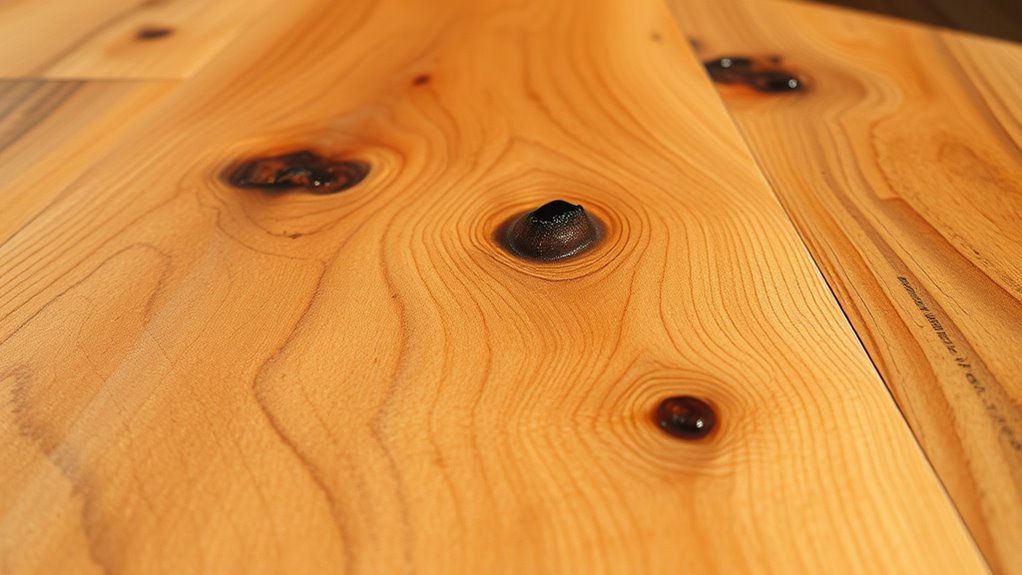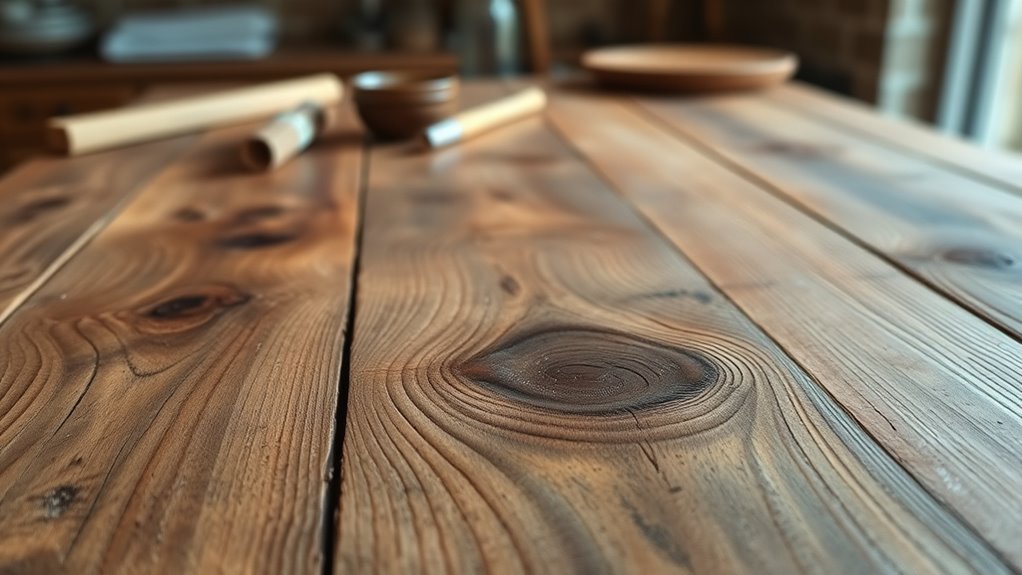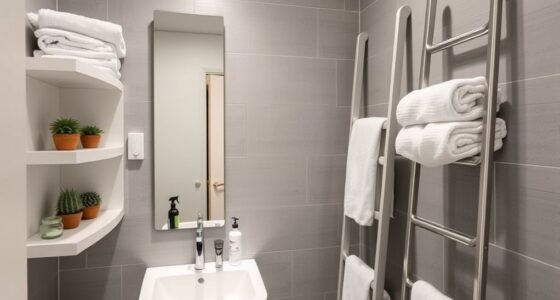To prepare reclaimed wood countertops, first verify the wood’s origin and inspect for damage or pests, then sand thoroughly to smooth the surface. Seal the wood with a high-quality, food-safe oil or sealant, applying multiple thin coats for durability. To care for it, clean spills immediately with mild soap, reapply oil periodically, and avoid hot pots directly on the surface. Proper maintenance helps preserve its natural beauty and longevity—if you choose to continue exploring, you’ll find more tips to keep your countertop looking great over time.
Key Takeaways
- Verify reclaimed wood from responsibly managed sources to ensure environmental sustainability and avoid contributing to deforestation.
- Carefully inspect and sand the wood to remove rot, insect damage, old finishes, and rough patches for a smooth, clean surface.
- Apply multiple coats of high-quality, food-safe sealant or oil to protect against moisture, stains, and scratches.
- Clean spills immediately with mild soap and water, and reapply sealant or oil periodically to maintain durability and appearance.
- Regularly sand minor scratches and reseal as needed to preserve the countertop’s longevity, beauty, and developing patina.

Reclaimed wood countertops are an excellent choice if you want to bring warmth and character into your space while supporting sustainability. When choosing reclaimed wood, it’s vital to consider sustainable sourcing. This means verifying that the wood comes from responsibly managed sources, such as old barns, warehouses, or furniture that’s been repurposed. Knowing the history of the wood ensures you’re not contributing to deforestation or environmental harm. Reclaimed wood often contains unique grains, knots, and imperfections that add charm and individuality to your kitchen. Plus, by opting for reclaimed materials, you’re helping reduce waste and giving new life to wood that might otherwise end up in landfills. Proper preparation begins with inspecting the wood carefully for any signs of rot, insect damage, or loose nails. Sanding the surface thoroughly is vital to remove old finishes, splinters, and rough patches. This not only smooths the surface but also helps eliminate any lingering contaminants. Applying a suitable primer or conditioner can improve adhesion for the finish you choose later. Once your reclaimed wood is prepped, sealing it becomes your next priority. Use a high-quality, food-safe sealant or oil designed for wood countertops to protect against moisture, stains, and scratches. Applying multiple thin coats ensures better coverage and durability. Remember, the right sealant enhances the wood’s natural beauty while providing a protective barrier that makes maintenance easier. Regular cleaning and reapplication of sealant help maintain its protective qualities. Maintaining your reclaimed wood countertop involves regular care and some simple maintenance tips. Always clean up spills immediately to prevent water damage or staining. Use a soft cloth or sponge with mild soap and water—harsh chemicals or abrasive scrubbers can damage the finish. Periodically, reapply a food-safe oil or sealant to keep the wood nourished and resistant to moisture. Avoid placing hot pots directly on the surface; use trivets or heat pads to prevent heat damage. To preserve its appearance, keep your countertop dry and avoid excessive exposure to sunlight, which can cause fading or warping over time. Sanding out minor scratches occasionally and resealing the surface helps maintain its integrity and beauty for years. With proper care, your reclaimed wood countertop will age gracefully, developing a rich patina that adds to its character. Additionally, selecting sustainable sourcing practices during the acquisition process supports environmentally responsible choices.
Frequently Asked Questions
How Long Do Reclaimed Wood Countertops Typically Last?
Reclaimed wood countertops can last 10 to 30 years, depending on durability factors like wood type and finish. You’ll want to follow maintenance tips such as regular cleaning, resealing when needed, and avoiding excessive moisture. Proper care helps prevent damage, ensuring your countertop stays beautiful and functional for many years. With good upkeep, reclaimed wood can be a long-lasting, sustainable choice for your kitchen or workspace.
Are Reclaimed Wood Countertops More Eco-Friendly Than New Wood?
You might wonder if reclaimed wood countertops are more eco-friendly than new wood. They often are because they come from sustainable sourcing, reducing the need for new trees. Using reclaimed wood lessens environmental impact by repurposing existing materials instead of harvesting fresh timber. This approach supports conservation efforts, lowers carbon footprint, and promotes sustainability, making reclaimed wood countertops a greener choice for your home.
Can Reclaimed Wood Countertops Be Used Outdoors?
Did you know that only 20% of reclaimed wood is suitable for outdoor use? Reclaimed wood countertops can be used outdoors, but their outdoor durability depends on weather resistance. If you want them to last, you’ll need to treat and seal the wood properly to withstand moisture, sun, and temperature changes. Without proper care, reclaimed wood may warp or rot, reducing its lifespan outdoors.
What Is the Cost Comparison Between Reclaimed and New Wood Countertops?
When comparing costs between reclaimed and new wood countertops, you’ll find a notable pricing analysis difference. Reclaimed wood often costs more upfront due to its unique character and sustainability, but it can be more durable with proper care. New wood countertops are usually cheaper initially but might require more maintenance over time. Consider material durability and long-term value when making your choice, balancing initial costs with longevity.
How Do I Repair Scratches or Damage on Reclaimed Wood Surfaces?
Scratches and surface damage on reclaimed wood surfaces are like scars telling a story. To repair scratches, gently sand the area with fine-grit sandpaper and apply a matching stain or finish. For deeper damage, consider filling with wood filler, then sanding smooth. Regular scratches repair keeps your reclaimed wood looking beautiful, preserving its character while maintaining its charm. Embrace these minor imperfections—they add to the history of your unique piece.
Conclusion
Taking care of your reclaimed wood countertops is like tending to a cherished garden—you need to prepare, seal, and maintain them with love and attention. By following the right steps, you’ll enjoy their rustic beauty for years to come. Regular cleaning and sealing are your tools to keep the wood looking vibrant and protected. With proper care, your countertops will age gracefully, becoming a stunning centerpiece that’s as warm and inviting as a cozy, sunlit cabin.










